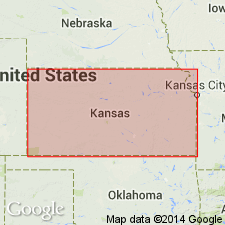
- Usage in publication:
-
- Flint Hills division
- Modifications:
-
- Original reference
- Dominant lithology:
-
- Shale
- Limestone
- AAPG geologic province:
-
- Nemaha anticline
- Forest City basin
Summary:
Pg. 3, 6-9. Flint Hills division. Lower division of Big Blue series. Divided into Chase limestones above (265 feet thick) and Neosho shales below (130 feet thick). Overlain by Sumner division. Age is Permian.
Named from Flint Hills, Cowley and Butler Cos., central KS.
Source: US geologic names lexicon (USGS Bull. 896, p. 742).

- Usage in publication:
-
- Flint Hills division†
- Modifications:
-
- Abandoned
- AAPG geologic province:
-
- Nemaha anticline
- Forest City basin
Summary:
†Flint Hills division [considered abandoned]. Not used in later classifications [post-Cragin 1896] of the Kansas Geol. Survey.
Source: US geologic names lexicon (USGS Bull. 896, p. 742).
For more information, please contact Nancy Stamm, Geologic Names Committee Secretary.
Asterisk (*) indicates published by U.S. Geological Survey authors.
"No current usage" (†) implies that a name has been abandoned or has fallen into disuse. Former usage and, if known, replacement name given in parentheses ( ).
Slash (/) indicates name conflicts with nomenclatural guidelines (CSN, 1933; ACSN, 1961, 1970; NACSN, 1983, 2005, 2021). May be explained within brackets ([ ]).

